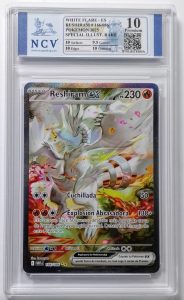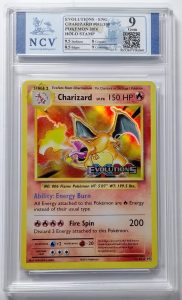How to grade Pokemon cards? What are they? And why are they so expensive?
Today we’re going to talk about some cards that have been in spectacular demand in recent years and whose number of collectors continues to grow year after year: Pokémon cards.

What is a Pokémon TCG card?
In 1996, the first Pokémon trading card game based on the Japanese red and green video games was launched. It quickly became a huge success among children due to its easy learning and possibility of competition among players. By 1999, due to its success in Japan, the brand expanded to the US and Europe. Those children of yesterday are now adults who, perhaps longing for their childhood, seek out those rare cards in excellent condition.

Why are Pokémon TCG cards so expensive?
Given such high global demand and considering that Pokémon cards were originally created as a game for children, astronomical sums are now paid for first editions in good condition. If they are already hard to find, it is even more difficult to find them in perfect condition. This exclusivity and rarity mean that rare Pokémon cards in good condition continue to increase in value. (Examples of highly valued cards)
There are also extremely rare cards in the new collections released in recent years. Nowadays, they are highly sought-after by collectors.
What is the most expensive Pokémon TCG card?
In order to find out which is the most expensive Pokémon card, we have to start with its rarity. Pikachu Illustrator is a unique card in perfect condition purchased by YouTuber Logan Paul for $5,275,000.
How to grade Pokémon TCG cards?
To grade Pokémon cards, you must consider the following points for evaluation:
- Surface: you must carefully evaluate the surface. Glossiness, colours, imperfections, stains, micro-scratches, misprints or any other issues detected will affect the degree of preservation your card receives upon grading.
- Centering: carry out accurate measurements to score the level of centering on your card. Pokémon cards often have printing deviations. An off-centered card won’t receive the same score as a perfectly centered one.
- Corners: examine the corners, analyzing their shape and cut. Any issues you observe will be taken into account when grading.
- Edges: examine the edges to detect bumps, retouching, pressure marks, miscuts and irregularities.

What are the most frequent issues when grading Pokémon cards?
The most common issues in old Pokémon collections tend to be:
- Lightning: white spots on card edges.
- Marks on the holographic foil, scratches, creases, pressure marks, etc.
- Typing mistakes.
In modern collections, due to high-volume production, a greater number of manufacturing and printing errors are being found.
Common issues in the most modern Pokémon collections tend to be:
- More frequent bad centering.
- Miscuts.
- Crimp: this happens when the card gets caught while sealing the packaging, thus leaving a mark on the surface.
- In the full art finish, the edges of the card are more likely to come loose and cause problems due to the type of engraving.
- In tag team cards, the upper and lower edges contain a white printed area that may be mistaken for wear or card defects.
- Alternate art cards, known as AA or SAR in their secret version, feature landscape backgrounds, so the issues we find in the printing traces are very faint and difficult to detect at first sight.

We are deeply grateful to Fco. José Crevillen Rodríguez for his cooperation and contribution to the writing of this article with his experience and knowledge. With over 30 years of experience collecting Pokémon cards, he has turned his hobby into his career thanks to his shop Poketradecenter.
https://www.cardmarket.com/es/Pokemon/Users/Poketradecenteresp
At NCV Grading, we specialise in grading your Pokémon cards and delivering them encapsulated with their rating in record time. If you want to take your Pokémon collection to the next level, contact us at https://ncvgrading.com/cartas/.
We hope you enjoyed this article and found it helpful if you are sending your Pokémon cards to be graded. You can read this post for more interesting information: https://ncvgrading.com/graduar-o-gradear-cartas-o-cromos-de-coleccion
